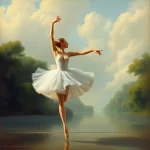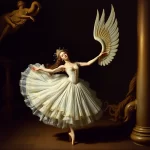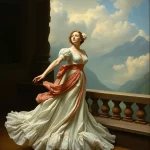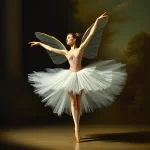Ballet: La Sylphide (Bournonville, 1836)

Introduction
La Sylphide is one of the oldest surviving romantic ballets, choreographed by August Bournonville with music composed by Herman Severin Løvenskiold. Premiering on November 28, 1836, at the Royal Danish Theatre in Copenhagen, this ballet has captivated audiences for nearly two centuries. The story revolves around a young Scotsman named James, who becomes enchanted by a sylph—a mythical forest spirit—leading to a series of events that explore themes of love, desire, and the supernatural.
Historical Background
Creation and Development
The early 19th century was a period of significant transformation in the arts, marked by the Romantic movement, which emphasized emotion, nature, and the supernatural. La Sylphide was created in this context, drawing inspiration from Charles Nodier’s 1822 story “Trilby, ou Le Lutin d’Argail.” The ballet’s ethereal themes and characters reflect the Romantic fascination with the mystical and the unattainable.
August Bournonville, a Danish ballet master, was inspired to create his version of La Sylphide after seeing Filippo Taglioni’s original 1832 production in Paris. Bournonville’s adaptation, however, introduced new choreography and a fresh musical score by Herman Severin Løvenskiold, making it distinct from its predecessor.
Premiere and Reception
La Sylphide premiered on November 28, 1836, at the Royal Danish Theatre in Copenhagen. The initial reception was overwhelmingly positive, with audiences and critics alike praising Bournonville’s innovative choreography and Løvenskiold’s evocative score. The ballet quickly became a staple of the Danish Royal Ballet’s repertoire and has since been revived numerous times worldwide.
Synopsis of the Ballet
Act I Summary
The ballet opens in a Scottish farmhouse where James is preparing for his wedding to Effie. As he dozes by the fireplace, a sylph appears and kisses him, awakening him from his slumber. Enchanted by her beauty, James becomes infatuated with the sylph, despite his impending marriage. The sylph vanishes as the household awakens, leaving James bewildered. Gurn, another suitor of Effie, tries to win her affection, but she remains devoted to James. The act concludes with James torn between his love for Effie and his fascination with the sylph.
Act II Summary
In the second act, James follows the sylph into the forest, abandoning his wedding. He encounters Madge, a witch who offers him a magical scarf that she claims will allow him to capture the sylph. Trusting her, James uses the scarf on the sylph, but it causes her wings to fall off, leading to her death. Devastated, James realizes he has been deceived by Madge. The act ends with James mourning the loss of the sylph as Effie marries Gurn.
Finale
The ballet concludes with a poignant scene where James is left alone, heartbroken and desolate. The sylph’s death symbolizes the tragic consequences of his unattainable desires, and the final image of James’s despair underscores the ballet’s themes of love, loss, and the ephemeral nature of beauty.
Musical Composition
Composer’s Role
Herman Severin Løvenskiold, a Norwegian composer, was tasked with creating the score for Bournonville’s La Sylphide. His music is characterized by its lyrical melodies and rich orchestration, which perfectly complement the ballet’s romantic and ethereal themes. Notable pieces include the sylph’s entrance music and the hauntingly beautiful finale.
Musical Themes and Motifs
Løvenskiold’s score features recurring musical themes that enhance the narrative and emotional depth of the ballet. The sylph’s leitmotif, for example, is a delicate, airy melody that underscores her otherworldly nature. The use of Scottish folk tunes also adds a sense of place and cultural context to the story.
Famous Recordings and Performances
Several iconic recordings of La Sylphide‘s music have been made over the years, including performances by the Royal Danish Orchestra and the London Symphony Orchestra. These recordings capture the timeless beauty of Løvenskiold’s score and continue to be celebrated by ballet enthusiasts worldwide.
Choreography and Dance
Choreographer’s Vision
August Bournonville’s choreography for La Sylphide is renowned for its light, airy movements and intricate footwork, reflecting the ethereal nature of the sylphs. Bournonville’s style emphasizes grace and fluidity, with an emphasis on storytelling through dance. His vision was to create a ballet that was both technically challenging and emotionally resonant.
Signature Dance Numbers
Key dance numbers in La Sylphide include the sylph’s solo in Act I, where she enchants James with her delicate movements, and the Pas de Deux between James and the sylph in Act II, which is a highlight of the ballet. These dances showcase Bournonville’s innovative choreography and the dancers’ technical prowess.
Notable Interpretations
Over the years, various productions of La Sylphide have interpreted Bournonville’s choreography in different ways. Some have emphasized the romantic elements, while others have focused on the ballet’s darker, more tragic aspects. Notable interpretations include those by the Royal Danish Ballet and the Paris Opera Ballet, each bringing their unique perspective to the classic work.
Characters and Roles
Main Characters
- James: A young Scotsman torn between his love for Effie and his fascination with the sylph.
- The Sylph: A mystical forest spirit who enchants James and ultimately leads to his downfall.
- Effie: James’s fiancée, who remains devoted to him despite his infatuation with the sylph.
- Madge: A witch who deceives James and causes the sylph’s death.
Supporting Characters
- Gurn: Another suitor of Effie who ultimately marries her.
- James’s Friends and Family: Various characters who appear in the opening scenes and contribute to the story’s development.
Famous Dancers
Notable dancers who have portrayed these roles include Erik Bruhn as James, Lis Jeppesen as the sylph, and Sorella Englund as Madge. Their performances have left a lasting impact on the ballet world and continue to inspire new generations of dancers.
Cultural and Artistic Impact
Influence on Ballet and Dance
La Sylphide has had a profound influence on the development of ballet as an art form. Its emphasis on storytelling through dance and its innovative choreography have inspired countless choreographers and dancers. The ballet’s themes of love, desire, and the supernatural continue to resonate with audiences today.
Cultural Significance
The ballet’s place in popular culture is evident in its numerous adaptations and references in literature, film, and other media. Its timeless story and captivating characters have made it a beloved classic that continues to be celebrated worldwide.
Legacy and Revivals
La Sylphide has been revived numerous times since its premiere, with major productions by companies such as the Royal Danish Ballet, the Paris Opera Ballet, and the Bolshoi Ballet. These revivals have kept the ballet alive and relevant, ensuring that new audiences can experience its magic.
Iconic Productions
Historic Productions
Historic productions of La Sylphide include the original 1836 premiere by the Royal Danish Ballet and the 1979 revival by the Paris Opera Ballet. These productions featured key figures such as August Bournonville, Erik Bruhn, and Lis Jeppesen, who brought their unique talents to the ballet.
Contemporary Productions
Recent productions of La Sylphide have continued to explore new interpretations of the ballet. Companies such as the Royal Ballet and the American Ballet Theatre have brought fresh perspectives to the classic work, incorporating modern elements while staying true to Bournonville’s original vision.
Production Design
The set, costume, and lighting design in various productions of La Sylphide have played a crucial role in bringing the ballet to life. From the rustic Scottish farmhouse to the mystical forest, the production design enhances the story’s atmosphere and emotional impact.
Critical Reception and Reviews
Initial Critical Response
At the time of its premiere, La Sylphide received glowing reviews from critics, who praised Bournonville’s choreography and Løvenskiold’s music. The ballet was hailed as a masterpiece of the Romantic era and quickly became a favorite among audiences.
Modern Reviews
Contemporary critics continue to celebrate La Sylphide for its timeless beauty and emotional depth. The ballet’s enduring popularity is a testament to its universal themes and the skill of its creators. Modern reviews often highlight the ballet’s innovative choreography and evocative score as reasons for its continued relevance.
Fun Facts and Trivia
Behind-the-Scenes Stories
One interesting anecdote from the production of La Sylphide involves Bournonville’s decision to cast his own father, Antoine Bournonville, in the role of Madge. This casting choice added a personal touch to the ballet and showcased the Bournonville family’s deep connection to the art form.
Notable Performers
Famous dancers associated with La Sylphide include Erik Bruhn, who is widely regarded as one of the greatest interpreters of the role of James, and Lis Jeppesen, whose portrayal of the sylph is considered iconic. Their performances have left a lasting legacy in the ballet world.
Trivia
- First Romantic Ballet: La Sylphide is often credited as one of the first romantic ballets, setting the stage for future works in the genre.
- Two Versions: There are two distinct versions of La Sylphide: the original 1832 version by Filippo Taglioni and Bournonville’s 1836 adaptation.
- Magical Scarf: The magical scarf used by James to capture the sylph is a key prop in the ballet, symbolizing the destructive power of unattainable desires.
Conclusion
Summary of the Ballet’s Importance
La Sylphide is a significant work in the world of dance, known for its innovative choreography, evocative music, and timeless themes. It has influenced countless choreographers and dancers and continues to be celebrated for its emotional depth and artistic beauty.
Final Thoughts
Reflecting on La Sylphide, it is clear why this ballet has endured for nearly two centuries. Its captivating story, enchanting characters, and exquisite choreography make it a masterpiece of the Romantic era. For those who have not yet experienced La Sylphide, watching a performance or listening to the score is highly recommended.
FAQ
What is the central theme of this ballet?
The central theme of La Sylphide is the conflict between human desires and the unattainable, symbolized by James’s infatuation with the sylph and the tragic consequences that follow.
Who are the main characters in this ballet?
The main characters in La Sylphide are James, the sylph, Effie, and Madge. Each character plays a crucial role in the unfolding drama and emotional depth of the story.
What is the most famous dance number in this ballet?
The most famous dance number in La Sylphide is the Pas de Deux between James and the sylph in Act II. This dance showcases the ethereal beauty and technical skill of the performers.
How long does a typical performance of this ballet last?
A typical performance of La Sylphide lasts approximately 1.5 to 2 hours, including intermissions.
Are there any modern adaptations of this ballet?
Yes, there have been several modern adaptations of La Sylphide, including contemporary productions by major ballet companies such as the Royal Ballet and the American Ballet Theatre.
Why is this ballet considered important in the history of dance?
La Sylphide is considered important in the history of dance because of its innovative choreography, evocative music, and its role in establishing the Romantic ballet genre. It has influenced countless works and continues to be celebrated for its artistic significance.





